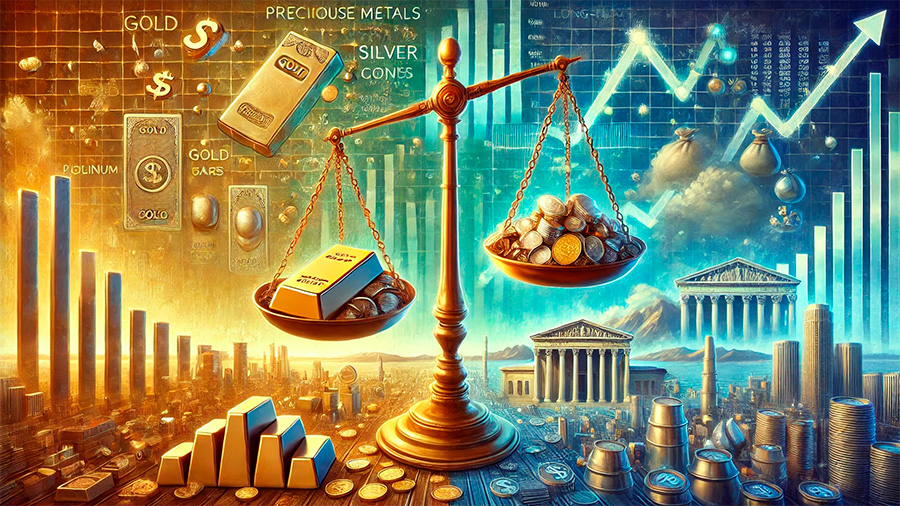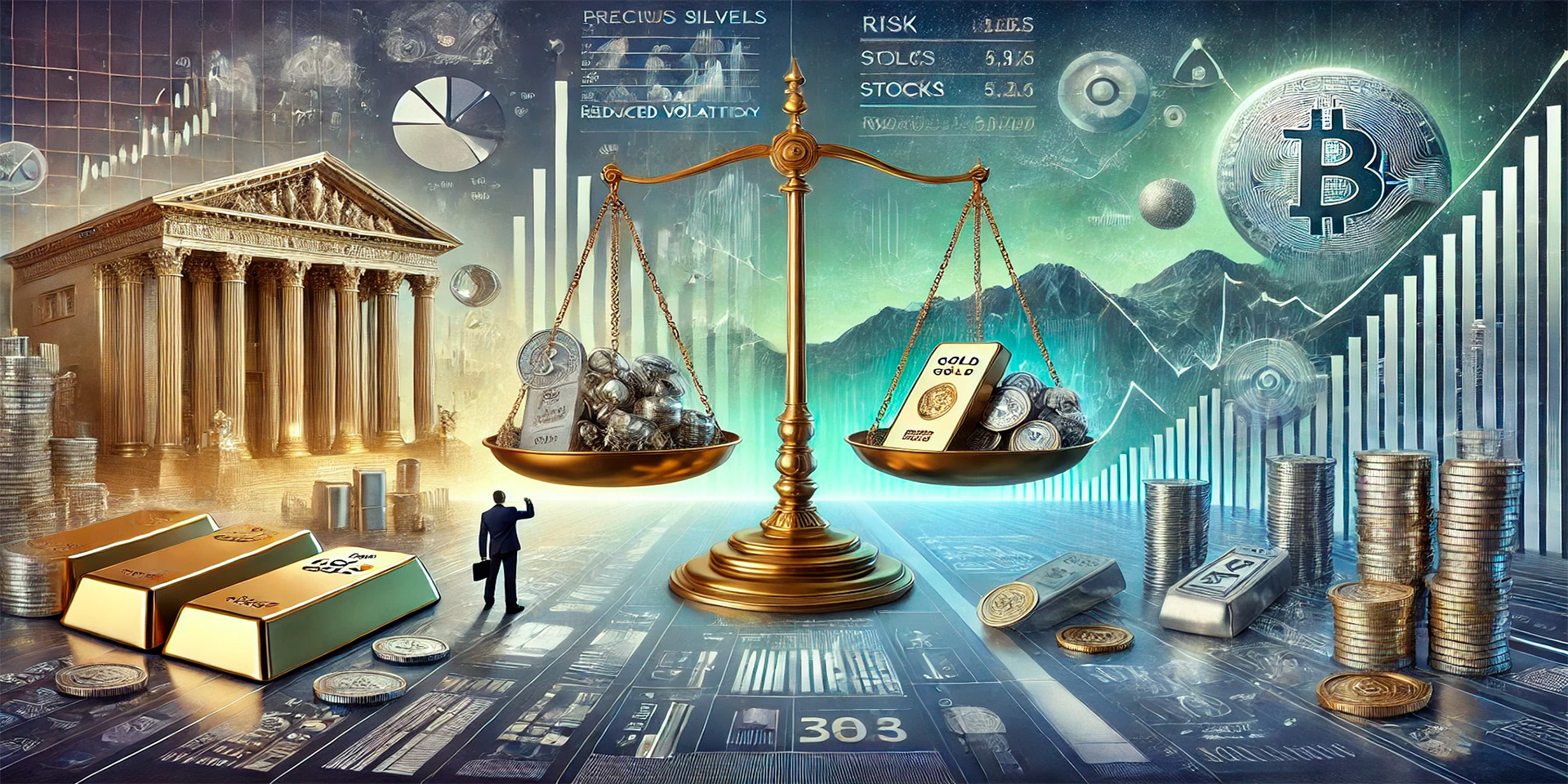In today’s volatile financial markets, investors are constantly seeking ways to mitigate risks and enhance the stability of their investment portfolios. One of the most reliable strategies for achieving this goal is diversification—spreading investments across various asset classes to reduce the impact of market fluctuations. Among the various asset classes, precious metals such as gold, silver, platinum, and palladium play a crucial role in portfolio diversification. This article explores how precious metals can help reduce risks, enhance stability, and provide long-term value in diversified investment portfolios.
The Importance of Diversification in Investment Portfolios
Diversification is a fundamental principle of sound investment strategy. It involves allocating investments across different asset classes—stocks, bonds, real estate, commodities, and precious metals—so that the performance of any single asset does not significantly affect the overall portfolio. This reduces risk and can improve returns, as different asset classes often behave differently in varying economic conditions.
1. How Diversification Reduces Portfolio Risk
By holding a variety of assets, investors can reduce the likelihood that the performance of any single asset will have a detrimental effect on the entire portfolio. If one asset class is underperforming, others may offset those losses, leading to a smoother overall return profile.
Key benefits of diversification:
- Minimized volatility: By including assets that move in different directions, such as precious metals and equities, the overall portfolio’s volatility is reduced, making it more stable over time.
- Risk reduction: Different asset classes respond to market events in various ways. While stocks might decline during economic downturns, precious metals like gold often rise, providing a hedge against losses.
- Improved returns: A well-diversified portfolio is likely to experience more consistent returns, as underperforming assets are balanced by others that perform better in certain economic environments.

The Role of Precious Metals in Portfolio Diversification
Precious metals, especially gold and silver, have long been considered a safe haven during times of market uncertainty and economic instability. By incorporating these metals into a diversified investment strategy, investors can reduce exposure to risks tied to traditional financial markets like stocks and bonds.
1. Precious Metals as a Hedge Against Inflation
One of the primary reasons investors turn to precious metals is their ability to hedge against inflation. As the value of fiat currencies erodes over time due to inflation, the value of precious metals like gold tends to rise. This makes them an excellent tool for protecting purchasing power during periods of high inflation.
How precious metals hedge against inflation:
- Gold’s historical performance: Gold has maintained its value for thousands of years, often rising in price when inflation reduces the value of currencies.
- Store of value: Unlike paper currencies, which can be printed in unlimited amounts, gold and silver are finite resources, providing a safeguard against inflationary pressures.
- Silver as a complementary hedge: Like gold, silver has historically been a strong performer in inflationary periods, providing an additional layer of protection for investors.
2. Gold: A Safe Haven in Times of Economic Instability
Gold is widely regarded as a “safe haven” asset—one that tends to hold its value during periods of economic or geopolitical uncertainty. During times of market volatility, financial crises, or political instability, the demand for gold often increases as investors seek a secure store of value.
The role of gold in economic downturns:
- Protection during market crashes: When stock markets experience significant declines, gold often rises in value, acting as a counterbalance to losses in traditional equities.
- Global demand for gold: Gold is universally recognized and accepted, making it a global store of wealth. This ensures that it remains valuable, even during times of local economic distress.
- Portfolio stability: By holding gold in a portfolio, investors can benefit from its inverse correlation with other assets like stocks and bonds, enhancing overall portfolio stability during turbulent times.
3. Silver and Other Precious Metals: Valuable Diversification Tools
While gold often takes the spotlight, silver and other precious metals like platinum and palladium also play important roles in a diversified portfolio. These metals, while not as universally recognized as gold, have significant industrial and financial uses, which influence their value and performance.
Benefits of incorporating silver and other precious metals:
- Silver as an industrial metal: Silver is used extensively in industries such as electronics, solar energy, and automotive manufacturing, which can drive demand and increase its value during periods of industrial growth.
- Platinum and palladium in automotive and technology sectors: These metals are crucial for catalytic converters in cars and various technological applications, providing an additional source of demand and value.
- Portfolio diversification: The inclusion of multiple precious metals with different uses helps to further diversify a portfolio, ensuring that it benefits from varying market conditions.

Why Precious Metals Enhance Portfolio Stability
Precious metals can offer more than just inflation protection—they also help investors maintain stability in their portfolios. By adding non-correlated assets like gold, silver, and platinum to a mix of equities and bonds, investors can protect themselves from extreme market fluctuations and unforeseen economic events.
1. Low Correlation with Traditional Assets
One of the key reasons precious metals are so valuable in portfolio diversification is their low correlation with traditional asset classes such as stocks and bonds. When the stock market is falling, precious metals often rise, and vice versa, allowing them to act as a buffer during turbulent financial periods.
The benefits of low correlation:
- Reduced overall portfolio volatility: Precious metals tend to move independently of equities and bonds, making them an effective way to smooth out the highs and lows of a portfolio.
- Protection during systemic crises: During financial crises or periods of extreme market instability, precious metals often retain their value while stocks and bonds experience sharp declines.
- Capital preservation: Precious metals act as a means of preserving capital, particularly in times of uncertainty, when other asset classes may fail to protect wealth.
2. Diversification and Long-Term Growth
Although precious metals are often viewed as a safe haven, they also offer long-term growth potential. Gold, silver, and other metals have historically appreciated in value over time, driven by both supply constraints and growing demand from industries and investors.
Long-term growth potential of precious metals:
- Demand-driven price increases: Growing industrial, technological, and investment demand for precious metals helps support their value over time, particularly in emerging markets.
- Store of wealth over generations: Precious metals have proven to be valuable assets for preserving wealth across multiple generations, making them an excellent choice for long-term investment.
- Scarcity and supply limitations: The finite nature of precious metals, coupled with challenges in mining and extraction, ensures that their supply will never meet the rising global demand, driving long-term appreciation.
How to Incorporate Precious Metals into a Diversified Portfolio
Including precious metals in an investment portfolio can be done through a variety of methods, each offering its own set of benefits and considerations. Investors should consider their overall financial goals, risk tolerance, and investment horizon when deciding how to incorporate these metals into their portfolios.
1. Direct Investment in Precious Metals
Investing directly in physical gold, silver, or other precious metals is one way to gain exposure to these assets. Investors can purchase bullion, coins, or bars and store them in secure facilities or safe-deposit boxes.
Pros of direct investment:
- Ownership of tangible assets: Investors physically own the precious metals, providing a sense of security and control.
- Protection against currency risk: Physical metals can serve as a hedge against currency devaluation, especially in uncertain economic times.
2. Exchange-Traded Funds (ETFs) and Mutual Funds
Exchange-traded funds (ETFs) and mutual funds that focus on precious metals offer a more liquid and accessible way to invest in gold, silver, and other metals. These funds typically hold physical metals or invest in mining companies, providing indirect exposure to precious metals.
Benefits of ETFs and mutual funds:
- Liquidity: ETFs and mutual funds are easily tradable on exchanges, providing liquidity and ease of access.
- Diversification: These funds may hold a mix of metals, or invest in precious metals companies, offering diversification within the precious metals asset class.
3. Mining Stocks and Precious Metal Funds
Investing in mining stocks allows investors to gain exposure to the potential growth of companies involved in the extraction of precious metals. Additionally, precious metals funds invest in a diversified portfolio of mining companies.
Benefits of investing in mining stocks:
- Growth potential: Mining companies can provide higher returns if precious metal prices rise, as they directly benefit from increased production and higher margins.
- Indirect exposure: Investing in stocks can provide indirect exposure to precious metals without owning physical metals.
Conclusion
Precious metals play a critical role in diversifying investment portfolios by offering protection against inflation, enhancing stability, and providing long-term growth potential. Their low correlation with traditional asset classes such as stocks and bonds makes them an effective hedge against economic uncertainty, market volatility, and financial crises. Whether through direct investment in physical metals, ETFs, or mining stocks, incorporating precious metals into a diversified portfolio is a smart strategy for reducing risk and ensuring long-term financial security.
